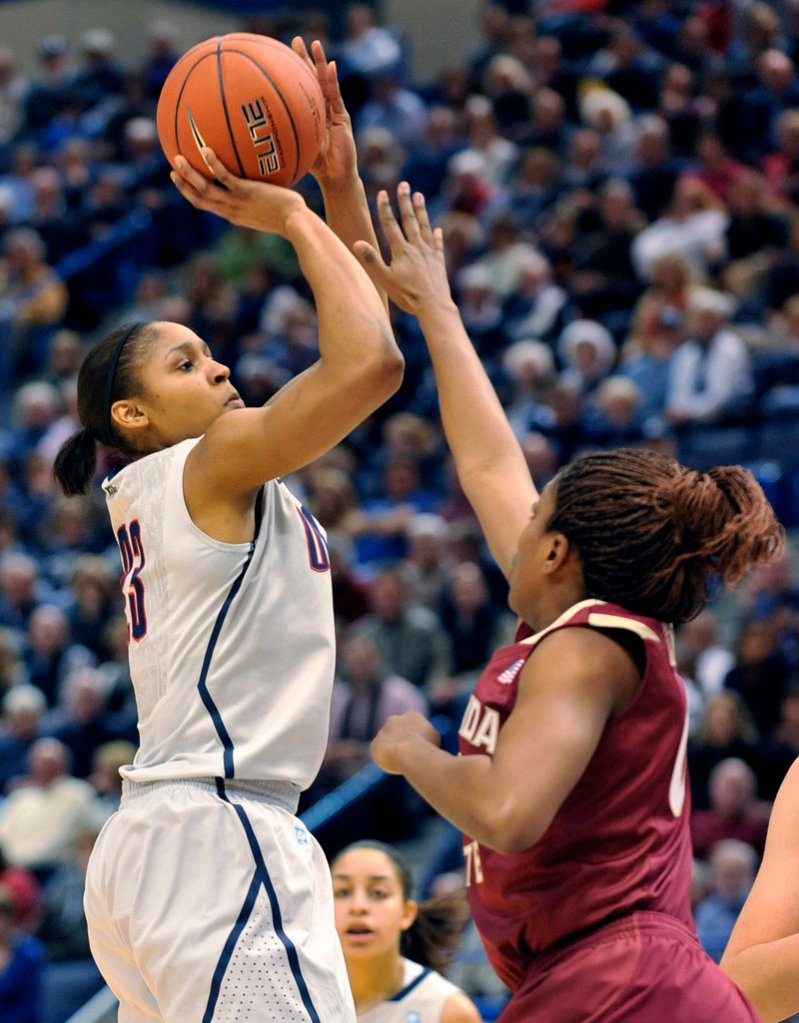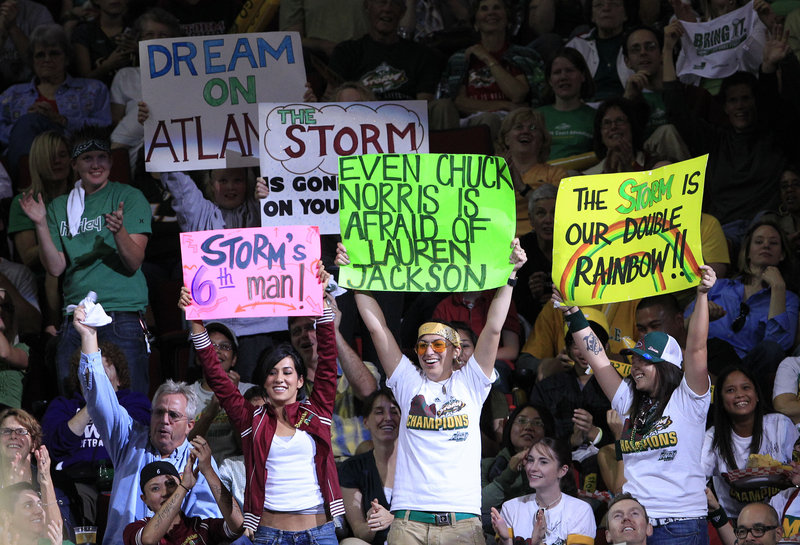It was a major milestone for college sports, and a special triumph for women’s basketball. With its victory over Florida State on Tuesday, the University of Connecticut women’s basketball team won its 89th straight game, breaking one of the most hallowed records in intercollegiate sports, the UCLA men’s streak of 88 straight victories from 1971 to 1974 under legendary coach John Wooden.
The nation’s sports media all but yawned at the news.
The record-breaking game was relegated to ESPN2, clearing the flagship ESPN channel to carry something called the Beef ‘O’ Brady’s Bowl. The UConn news rated a wire-service story in The Washington Post’s Sports section and inside-the-section play in the New York Times. Sports talk radio stations barely touched it.
Women and girls are playing sports in vast numbers, propelled onto the court and into the field by Title IX, the 1972 law that effectively outlawed discrimination in funding for public-school sports programs. Between the law’s enactment and 2008, the number of girls playing high school sports grew tenfold, according to the Women’s Sports Foundation.
Fans are a different story. One reason is that men — generally the most passionate and loyal sports fans — aren’t keen on watching women’s sports. But if anything, women show even less interest in the games women play. Women haven’t grown into the sorts of sports fans that can sustain professional leagues or boost a women’s game into the national spotlight.
Women’s games don’t draw the crowds, the money or the media attention that even “minor” sports played by men attract. Only a few women’s sports – golf and tennis, primarily – have strong enough followings for lengthy regular seasons. Others, such as gymnastics and figure skating, surge in popularity in Olympic years largely on the strength of female viewers but slide back into relative obscurity in off years.
As a result, attempts to market women’s sports have floundered. A women’s pro softball league lasted four years before folding in 2001, and a women’s pro soccer league made it three years before collapsing in 2003 (both have since been revived, though greatly scaled back). Several women’s professional volleyball leagues have failed, with another planned.
The Women’s National Basketball Association, meanwhile, has grasped for survival. In 14 seasons, only one franchise, the Connecticut Sun, has ever reported an annual profit, despite the WNBA’s limited summer schedule, strict pay cap (maximum player salary this year: $101,500) and early support from the NBA. Washington’s team, the Mystics, recently dismissed its coach and general manager in an effort to save money.
Kathryn Olson surveys this dismal landscape with some regret. As chief executive of the Women’s Sports Foundation, her mission is to promote greater participation and opportunities for women and girls. But it’s one thing for girls to play, she says; they also need support — from family, friends and the culture at large.
“Girls see the difference at a young age,” Olson says. “There are more people watching her brother when he plays than when she does. . . . We’re still at the point where spectatorship is not there. I don’t know what the right timeline is, but you always wish it would be faster. It’s been a slow ramp-up. I’m hopeful that it won’t continue at this pace.”
In part, Olson says, the media are to blame for not giving female athletes a higher profile. “When people get to know the athletes, it builds interest in them,” she says. “Right now, (coverage of women) is right up there on the sports pages with horses, dogs and fishing.”
It’s true that women’s sports get far less ink and airtime than men’s. ESPN’s “SportsCenter,” for example, devoted just 1.4 percent of its coverage to female athletes or games in 2009, according to a study by the Center for Feminist Research at the University of Southern California. The figure for sports reports on TV stations in the Los Angeles area wasn’t much better: a mere 1.6 percent.
But the scanty coverage raises the classic which-came-first question: Does a lack of media attention cause lack of interest in women’s sports or simply reflect it?
“Follow the money,” answers David Carter, executive director of the Sports Business Institute at USC. The multibillion-dollar sports business, Carter points out, is driven largely by the desires and preferences of male fans. They’re the primary consumers of sports tickets and merchandise, the main audience for sports radio and sports news, and the target audience for sports advertisers.
Women? “You can legislate (equal funding for sports), but you can’t mandate that (women) consume sports the way men do,” Carter says. “If there was more interest, I guarantee you there would be more coverage.”
Andrei Markovits has been exploring the role gender plays in sports fandom through his research and teaching at the University of Michigan. In one study of undergraduates, Markovits found profound (though perhaps anecdotally evident) differences: Men watch far more sports television, talk about sports more and have far wider knowledge of teams, players and statistics than women.
Markovits can’t definitively answer the bigger question – why? – but he suspects it has something to do with early childhood. Young women with the greatest interest in and knowledge of sports tend to have had an older family member who took them to games, watched sports with them on TV or otherwise immersed them in “sports culture.”
“I don’t think there a clear, definitive reason,” he says. “It’s a social construct. It says something about how we’re socialized as human beings.”
Send questions/comments to the editors.




Success. Please wait for the page to reload. If the page does not reload within 5 seconds, please refresh the page.
Enter your email and password to access comments.
Hi, to comment on stories you must . This profile is in addition to your subscription and website login.
Already have a commenting profile? .
Invalid username/password.
Please check your email to confirm and complete your registration.
Only subscribers are eligible to post comments. Please subscribe or login first for digital access. Here’s why.
Use the form below to reset your password. When you've submitted your account email, we will send an email with a reset code.